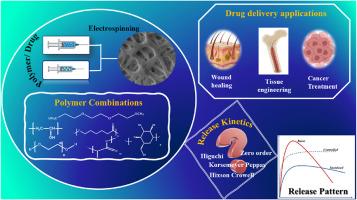A review of electrospun polymeric fibers as potential drug delivery systems for tunable release kinetics
IF 6.8
3区 材料科学
Q1 MATERIALS SCIENCE, MULTIDISCIPLINARY
Journal of Science: Advanced Materials and Devices
Pub Date : 2025-06-16
DOI:10.1016/j.jsamd.2025.100933
引用次数: 0
Abstract
Recently, the pursuit of innovative targeted drug delivery strategies has been one of the major frontiers in biomedical research. Electrospun nanofibers have emerged as an appealing vehicle for drug delivery owing to their remarkable drug-loading efficiency and adaptability in enabling drug administration through multiple delivery routes. This review overviews the potential of electrospinning in generating polymeric fibers as an efficient delivery vehicle. It outlines the fundamentals of electrospinning process, key parameters influencing the fiber characteristics, and the advantages of electrospun fibers that outperform traditional carriers. The essence of drug delivery and the secret underlying the selection of optimal drug-carrier pairs are also discussed in detail with the recent literature support. This study compares synthetic/natural and hydrophilic/hydrophobic polymer combinations as superior drug carriers in regulating the release patterns compared to individual polymer-carriers. A comprehensive discussion on drug release patterns, the mechanism of release, the necessity for tailoring release kinetics, and the selection of best-fit models for drug release gives insights into the design of delivery platforms. Drawing on recent advances, this article also delves into the advancing fields of tissue engineering, wound care, and cancer therapy, where an electrospun polymeric delivery system transforms the treatment strategies with patient-compiled, site-specific, controlled, and sustained therapeutic outcomes. Overall, this study emphasizes electrospun polymeric fibers as a promising solution in resolving current drug delivery challenges as a potential vehicle for drug delivery.

综述了电纺丝聚合物纤维作为可调释放动力学的潜在药物递送系统
近年来,追求创新的靶向给药策略已成为生物医学研究的主要前沿之一。电纺丝纳米纤维由于其显著的载药效率和可通过多种给药途径给药的适应性而成为一种有吸引力的药物递送载体。本文综述了静电纺丝作为一种高效的输送载体在生产聚合物纤维方面的潜力。概述了静电纺丝工艺的基本原理,影响纤维特性的关键参数,以及静电纺丝纤维优于传统载体的优点。药物传递的本质和选择最佳药物载体对的秘密也在最近的文献支持下进行了详细讨论。本研究比较了合成/天然和亲水/疏水聚合物组合作为药物载体在调节释放模式方面优于单个聚合物载体。全面讨论药物释放模式,释放机制,定制释放动力学的必要性,以及药物释放的最佳拟合模型的选择,为药物释放平台的设计提供了见解。根据最近的进展,本文还深入研究了组织工程,伤口护理和癌症治疗的前沿领域,其中电纺丝聚合物输送系统改变了治疗策略,具有患者编译,部位特异性,控制和持续的治疗结果。总的来说,这项研究强调了电纺聚合物纤维作为一种潜在的药物递送载体,在解决当前药物递送挑战方面是一种很有前途的解决方案。
本文章由计算机程序翻译,如有差异,请以英文原文为准。
求助全文
约1分钟内获得全文
求助全文
来源期刊

Journal of Science: Advanced Materials and Devices
Materials Science-Electronic, Optical and Magnetic Materials
CiteScore
11.90
自引率
2.50%
发文量
88
审稿时长
47 days
期刊介绍:
In 1985, the Journal of Science was founded as a platform for publishing national and international research papers across various disciplines, including natural sciences, technology, social sciences, and humanities. Over the years, the journal has experienced remarkable growth in terms of quality, size, and scope. Today, it encompasses a diverse range of publications dedicated to academic research.
Considering the rapid expansion of materials science, we are pleased to introduce the Journal of Science: Advanced Materials and Devices. This new addition to our journal series offers researchers an exciting opportunity to publish their work on all aspects of materials science and technology within the esteemed Journal of Science.
With this development, we aim to revolutionize the way research in materials science is expressed and organized, further strengthening our commitment to promoting outstanding research across various scientific and technological fields.
 求助内容:
求助内容: 应助结果提醒方式:
应助结果提醒方式:


